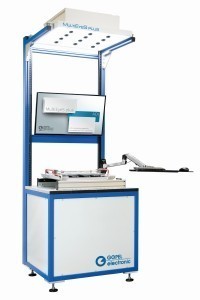Despite the rapid increase in automation, many assembly processes in industrial production will still be carried out manually in the foreseeable future.
Quality assurance through intelligence and excellent resolution
Due to the complex structure of the products and/or the high degree of individuality of the product variants, complete automation of assembly is not economically viable in such cases. In addition, manual assembly is often the only way to achieve efficient added value in view of ever shorter product cycles. Examples of such assembly processes can be found in a wide variety of industries. For example, manual production processes can be found in the pre-assembly of automotive assemblies, in the assembly, packaging or cleaning of medical products or in the assembly of THT (through-hole technology) components. In all these cases, the question arises as to how the quality of the corresponding production processes can be monitored. An innovative and pragmatic approach is the direct integration of optical inspection systems into assembly or placement stations, which is also combined with automatic logging.
Many eyes
However, the direct integration of optical inspection into the assembly process requires completely new and original device concepts compared to traditional AOI systems. The cameras for inspection must be arranged in such a way that they do not interfere with the assembly process of the people working there. The lighting cannot be optimized for the requirements of image processing, but must meet the legal requirements of a workplace for assembly processes. In addition, light-shielding cladding is not possible, as this would restrict the manual assembly process. Fig. 2: Multi-camera array of the MultiEyeS plus
Fig. 2: Multi-camera array of the MultiEyeS plus
With the 'MultiEyeS plus', GOEPEL electronic has developed an inspection module that is ideally suited to the application described, which is suitable for an image area of approx. 550 x 450 mm. The system is based on an image acquisition unit consisting of up to 12 cameras with integrated lighting. The individual images from the cameras are combined to form a common image known from panoramic photography. All inspections are carried out on the overall image. Thanks to the innovative multi-camera image capture, the smallest details can be resolved with a remarkably high image quality despite the large image field. This ensures the reliable detection of defects in the test objects or makes it possible, for example, to read barcodes or 2D codes on subcircuits in electronics production.
The module is designed to be mounted directly above the assembly station. Additional light shielding measures are not necessary.
Artificial intelligence
From the point of view of classic image processing, such an open system is of course not ideal. However, the powerful software makes it possible to always make the right decisions, even under such conditions. For this purpose, the classic approaches are supplemented by an AI-based solution, which, thanks to the relative insensitivity of convolutional neural networks to fluctuations in brightness and position, provides ideal conditions for reliably recognizing objects placed by hand. However, approaches based on neural networks require a large number of examples in order to be able to process complex problems. This hurdle of obtaining high-quality data is overcome by a self-learning approach, which is based on a system of mathematical-statistical methods and machine learning methods complementing each other. If the system is not 'sure', i.e. the mathematical and neuronal models are drastically contradictory, additional training content can be requested using an active method. For this purpose, a human expert is presented with a training example of the system at any point in the process. The interaction of human expertise, mathematical models and the adaptability of the neural networks results in a trained model in a very short time and with little human effort, which enables reproducible inspection even under unfavorable image acquisition and lighting conditions.
Traceability
In addition to reliable and reproducible fault detection, the complete documentation of inspection and process data is an increasingly important issue in the age of Industry 4.0. This includes, in particular, the connection to manufacturing execution systems (MES). A sophisticated plug-in system of the electronic software PILOT Connect ensures fast and efficient connection to such systems. In the PILOT Connect interface to the MES, data is exchanged both at pure result level (unidirectional) or with product-specific control and process interlocking (bidirectional). Extensive statistical evaluation options round off the overall concept. Fig. 3: AOI module for assembly processes and THT placement
Fig. 3: AOI module for assembly processes and THT placement
Conclusion
With the MultiEyeS plus, GOEPEL offers a smart automatic optical inspection module for integration into assembly and THT placement stations that is optimally tailored to the requirements of such processes. The system concept based on multi-camera image acquisition technology enables image acquisition with outstanding image quality and excellent detail resolution. In addition to the classic image processing functions, the AI functions used ensure that the system works completely reliably even without light shielding. This modern approach to optical inspection directly at assembly stations, combined with the simple connection to MES systems, offers great potential for further optimizing assembly processes and, in particular, the assembly of THT components.


